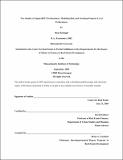| dc.contributor.advisor | David Geltner. | en_US |
| dc.contributor.author | Konagai, Rena | en_US |
| dc.contributor.other | Massachusetts Institute of Technology. Center for Real Estate. Program in Real Estate Development. | en_US |
| dc.date.accessioned | 2010-05-25T19:20:36Z | |
| dc.date.available | 2010-05-25T19:20:36Z | |
| dc.date.copyright | 2009 | en_US |
| dc.date.issued | 2009 | en_US |
| dc.identifier.uri | http://hdl.handle.net/1721.1/54855 | |
| dc.description | Thesis (S.M.)--Massachusetts Institute of Technology, Program in Real Estate Development in Conjunction with the Center for Real Estate, 2009. | en_US |
| dc.description | This electronic version was submitted by the student author. The certified thesis is available in the Institute Archives and Special Collections. | en_US |
| dc.description | Cataloged from student submitted PDF version of thesis. | en_US |
| dc.description | Includes bibliographical references (p. 62-63). | en_US |
| dc.description.abstract | This paper is intended to recognize the performance of REITs in Japan (J-REITs) by conducting two kinds of studies in a REIT-level and an underlying property-level: first, to do "factor loadings" that identify systematic risks of long run investment performance in J-REITs; second, to demonstrate "Pure Play Indices," segment-specific indices of REIT-based property market returns by tracking monthly REIT return data and property holding data. The first study employs the Fama-French three-factor model for monthly J-REIT returns from September 2001 to September 2008. This investigation upgrades past similar research with longer data periods in a two-stage regression (a time-series regression and a cross-sectional regression) for all the listed J-REITs. Nevertheless, the model results in a limited explanatory power for the J-REIT performance, probably due to too short a market history, as in the past research. The second study applies the Pure Play Indices, originally proposed by Geltner and Kluger [1995, 1998], to the J-REITs for office, residential, and retail segments since January 2006 when the J-REIT market became sizable enough for study. The developed Pure Play Indices perform similarly with the J-REIT return indices, except the Pure Play Residential Index during the down market due to the effect of non-target segments within the J-REITs. The reason for this effect will require a further study. As the market matures with more data accumulated, this two-fold study that shows demonstration of returns from J-REITs will become more valuable to derive risk of J-REITs and different types of information of properties. | en_US |
| dc.description.statementofresponsibility | by Rena Konagai. | en_US |
| dc.format.extent | 63 p. | en_US |
| dc.language.iso | eng | en_US |
| dc.publisher | Massachusetts Institute of Technology | en_US |
| dc.rights | M.I.T. theses are protected by
copyright. They may be viewed from this source for any purpose, but
reproduction or distribution in any format is prohibited without written
permission. See provided URL for inquiries about permission. | en_US |
| dc.rights.uri | http://dspace.mit.edu/handle/1721.1/7582 | en_US |
| dc.subject | Center for Real Estate. Program in Real Estate Development. | en_US |
| dc.title | Two studies of Japan-REIT performance : modeling risk and tracking property-level performance | en_US |
| dc.type | Thesis | en_US |
| dc.description.degree | S.M. | en_US |
| dc.contributor.department | Massachusetts Institute of Technology. Center for Real Estate. Program in Real Estate Development. | en_US |
| dc.contributor.department | Massachusetts Institute of Technology. Center for Real Estate | |
| dc.identifier.oclc | 609649696 | en_US |
